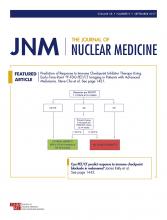TO THE EDITOR: I applaud the authors of the recent article by Siegel et al., “Subjecting Radiologic Imaging to the Linear No-Threshold Hypothesis: A Non Sequitur of Non-Trivial Proportion” (1), and The Journal of Nuclear Medicine for publishing this important review in such a prominent journal. The authors condense an enormous amount of scientific data and rigorous interpretation into a relatively small space. I hope this paper will help slow the disheartening impact of radiophobia that is sweeping our country and reducing the quality and use of radiologic imaging and consequently of medical care, as described so clearly in the article. The authors have raised the level of scientific discussion regarding the health effects of radiation. Any rebuttal to their cogent arguments needs to be on that same high scientific level. I think part of the wide acceptance of the linear, no-threshold theory is the unfamiliarity of most people with the widespread biologic phenomenon of the J-shaped curve, namely, that many things that are harmful at high doses are harmless, or even helpful, at low doses. The classic and best-studied example is that of alcohol on all-cause human mortality, nicely summarized in Figure 1 modified from Di Castelnuovo et al. (2), a metaanalysis involving more than 1 million subjects. The data in the red circle in Figure 1A are shown larger in Figure 1B, and clearly demonstrate the strikingly nonlinear relationship between alcohol and mortality at low doses. This corresponds to the area of contention in the radiation–cancer relationship (equivalent to several whole-body CT scans), for which there are no data—or rather, the data at such low radiation doses are so noisy that no reliable signal can be discerned above background. The data are much better for alcohol and show a relationship that could never be predicted from the high-dose data.
Relative risk of mortality with increasing alcohol consumption. Note that the relationship is nonlinear at low doses, and that alcohol is beneficial at low doses, while harmful at high doses. (Reprinted with permission of (2)).
Footnotes
Published online Apr. 27, 2017.
- © 2017 by the Society of Nuclear Medicine and Molecular Imaging.








